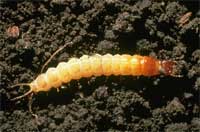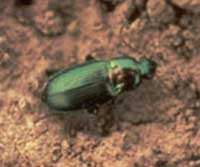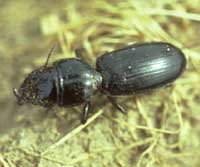Urbana, Illinois
March 24, 2006Source:
The
Bulletin - University of
Illinois
Original:
http://www.ipm.uiuc.edu/bulletin/article.php?id=443
|
 |
|
Ground
beetle larva |
|
 |
|
Ground
beetle adult |
|
 |
|
Ground
beetle adult |
The use of
transgenic corn hybrids (Bt corn) continues to increase in
popularity for a variety of lepidopteran pests (European corn
borer, black cutworm, western bean cutworm), as well as tor the
corn rootworm complex (western and northern corn rootworms). The
increased use of Bt corn has been accompanied by an escalation
in the use of neonicotinoids, which are used to treat transgenic
corn seed, as well as seed of many nontransgenic corn hybrids.
The two neonicotinoids most commonly used in corn production are
clothianidin (Poncho) and thiamethoxam (Cruiser). Corn seed may
be treated at 1.125 mg of active ingredient (AI) per kernel with
thiamethoxam and 1.25 mg of AI per kernel with clothianidin for
corn rootworm control. Lower rates of each product
(thiamethoxam--0.125 mg of AI per kernel; clothianidin--0.25 mg
of AI per kernel) are labeled for use as seed treatments against
secondary soil insects. Does the prophylactic use of these
neonicotinoid seed treatments fit within the conventional IPM
paradigm? How concerned should we be regarding the potential for
resistance development to these systemic insecticides in the
corn and soybean agroecosystem? Why are producers mandated to
deploy a refuge strategy for Bt hybrids but not for
neonicotinoids? What impact, if any, do the neonicotinoids and
Bt hybrids have on nontarget populations of insects? These and
many other questions will continue to be asked in the coming
years as the use of transgenic hybrids becomes routine.
The National
Agricultural Statistics Service (NASS, USDA) estimated (June 30,
2005) that 81.6 million acres of corn were planted in the United
States in 2005, an increase of 1% from 2004 and 4% from 2003.
The use of Bt hybrids on 28.6 million acres accounted for 35% of
the 2005 U.S. corn acreage. NASS estimated that 12.1 million
acres of corn were planted in Illinois in 2005, of which 30%
(3.63 million acres) were Bt hybrids. Five percent of the Bt
hybrids planted in Illinois were the "stacked" gene hybrids that
include biotech traits for herbicide and insect resistance. The
use of Bt hybrids in western Corn Belt states was greater than
in the eastern Corn Belt states in 2005: Indiana (15%), Iowa
(46%), Kansas (33%), Michigan (20%), Minnesota (44%), Missouri
(43%), Nebraska (51%), Ohio (11%), South Dakota (52%), and
Wisconsin (28%). Greater use of Bt hybrids in western states can
be explained by more continuous (nonrotated) corn, more
livestock production, and fewer concerns about the overseas
export market (particularly Europe) regarding transgenic grain.
The use of all transgenic corn (Bt and herbicide-resistant)
hybrids in 2005 exceeded 50% of planted acres in many Corn Belt
states: Illinois (36%), Indiana (26%), Iowa (60%), Kansas (63%),
Michigan (40%), Minnesota (66%), Missouri (55%), Nebraska (69%),
Ohio (18%), South Dakota (83%), and Wisconsin (46%). In 2005, an
estimated 52% of the corn acres in the United States were
planted to transgenic hybrids. Within a 10-year span, the manner
in which producers manage two very important insect pests of
corn (European corn borer and corn rootworms) has fundamentally
changed. This transformation has caused scientists engaged in
integrated pest management (IPM) research and extensions within
land grant institutions to reexamine their definitions of IPM
and to question some previously held convictions about IPM,
which had its formal roots in the late 1950s.
Some research on
the potential effects of Bt corn hybrids on nontarget insects
has been published. Of particular interest is the potential
effect of the Cry3Bb1 protein against beneficial soil insects
such as ground beetles (carabids) and other nontarget soil
organisms. The Cry3Bb1 protein is expressed in YieldGard
Rootworm hybrids for control of corn rootworms. Research
conducted by Kansas State University entomologists and published
in 2003 and 2005 led scientists to offer these concluding
remarks:
"In general, the
results of this study demonstrated that Bt corn expressing the
Cry3Bb1 protein for corn rootworm control does not have
deleterious effects on the nontarget microarthropods and
nematodes sampled. Further studies on soil after repeated
growing of Bt corn in the same field for several years are
needed." (Al-Deeb, M.A., G.E. Wilde, J.M. Blair, and T.C. Todd.
2003. Effect of Bt corn for corn rootworm control on nontarget
soil microarthropods and nematodes. Environmental Entomology
32: 859-865.)
"In conclusion,
our studies indicated that transgenic Bt corn expressing Cry3Bb1
was not detrimental to surface or below-ground arthropod
communities. None of the Cry3Bb1 protein or only a trace amount
was detected from soil near the base of the plants. Furthermore,
there was no indication of protein accumulation over a 3-year
period." (Ahmad, A., G. Wilde, and K.Y. Zhu. 2005. Detectability
of coleopteran-specific Cry3Bb1 protein in soil and its effect
on nontarget surface and below-ground arthropods.
Environmental Entomology 34: 385-394.)
In 2006, a few
researchers with Monsanto Company, in cooperation with
scientists formerly with the Illinois Natural History Survey,
published a paper that specifically focused on a dietary
exposure bioassay with Cry3Bb1 targeted at larvae of one species
of ground beetle, Poecilus chalcites (Say). They offered
the following comments in their discussion:
"Results from this
study show that the Cry3Bb1 protein at 10 times the maximum
concentration expressed in MON 863 corn tissues (930 µg/g of
diet) had no apparent adverse effects on the survival, growth,
and development of larvae of P. chalcites, and thus is
expected to pose no risk to this nontarget beneficial insect."
(Duan, J.J., M.S. Paradise, J.G. Lundgren, J.T. Bookout, C.
Jiang, and R.N. Wiedenmann. 2006. Assessing nontarget impacts of
Bt corn resistant to corn rootworms: tier-1 testing with larvae
of Poecilus chalcites (Coleoptera: Carabidae).
Environmental Entomology 35: 135-142.)
Are we ready to
conclude that Bt corn rootworm hybrids have minimal impact, if
any, on nontarget populations of soil arthropods? Not yet. A
recently published paper has shed some light on the potential
negative impact of neonicotinoid systemic insecticides that are
used as seed treatments on transgenic corn hybrids:
"A series of
laboratory-feeding and defined-dose bioassays effectively
delivered or exposed representative carabid species collected
from these field plots to Cry toxins and seed treatments. We
found that the neonicotinoid/fungicide seed treatments, and not
Cry3Bb1, were a major mortality factor for the 16 ground beetle
species tested." (Mullin, C.A., M.C. Saunders II, T.W. Leslie,
D.J. Biddinger, and S.J. Fleischer. 2005. Toxic and behavioral
effects to Carabidae of seed treatments used on Cry3Bb1- and
Cry1Ab/c-protected corn. Environmental Entomology 34:
1626-1636.)
The researchers
further commented on the importance of conducting future field
studies: "Field studies are needed to determine population and
community level effects on Carabidae when these transgenic and
seed-treatment technologies are combined." The potential threat
of neonicotinoids to nontarget insects can be expanded to
include soybean seed treated with neonicotinoids (thiamethoxam
and imidacloprid [Gaucho]).
With respect to
potential development of insecticide resistance to
neonicotinoids, how concerned should we be? Western corn
rootworms have developed resistance to chlorinated hydrocarbons,
organophosphates, and carbamates, and even crop rotation has
lost its usefulness as a pest management tactic against western
corn rootworms throughout much of Illinois. The western corn
rootworm is quite capable of adapting when "squeezed" too hard.
Resistance to neonicotinoids has occurred with other beetles in
the same family (Chrysomelidae) as corn rootworms. Resistance to
imidacloprid was documented for the Colorado potato beetle in
the following paper:
"Colorado potato
beetle, Leptinotarsa decemlineata (Say), adults and
larvae collected from Long Island, NY, were 100.8 and 13.2 times
more resistant to imidacloprid, respectively, compared with a
susceptible strain. This high level of resistance appeared in
only the third field season of imidacloprid use." (Zhao, J.-Z.,
B.A. Bishop, and E.J. Grafius. 2000. Inheritance and synergism
of resistance to imidacloprid in the Colorado potato beetle
(Coleoptera: Chrysomelidae). Journal of Economic Entomology
93: 1508-1514.)
The authors of
this 2000 paper offered additional comments regarding the
potential management of imidacloprid resistance: "Our results
indicate that autosomal, incompletely recessive factors are
involved in imidacloprid resistance. Thus, resistance management
practices such as refugia and high doses, which rely on
recessive resistance traits, may be more successful for managing
resistance to imidacloprid than was the case for other
insecticides."
Based on the
findings presented in this paper, the use of a refuge as part of
an overall resistance management plan for neonicotinoid use
within the corn and soybean production system warrants
discussion. In addition, because we are using the lower rates of
neonicotinoids on Bt corn, are we additionally increasing the
potential threat of development of resistance? We look forward
to our readers' responses to these questions.--Mike Gray and
Kevin Steffey
Authors:
Kevin Steffey and
Mike Gray
Original:
http://www.ipm.uiuc.edu/bulletin/article.php?id=443 |